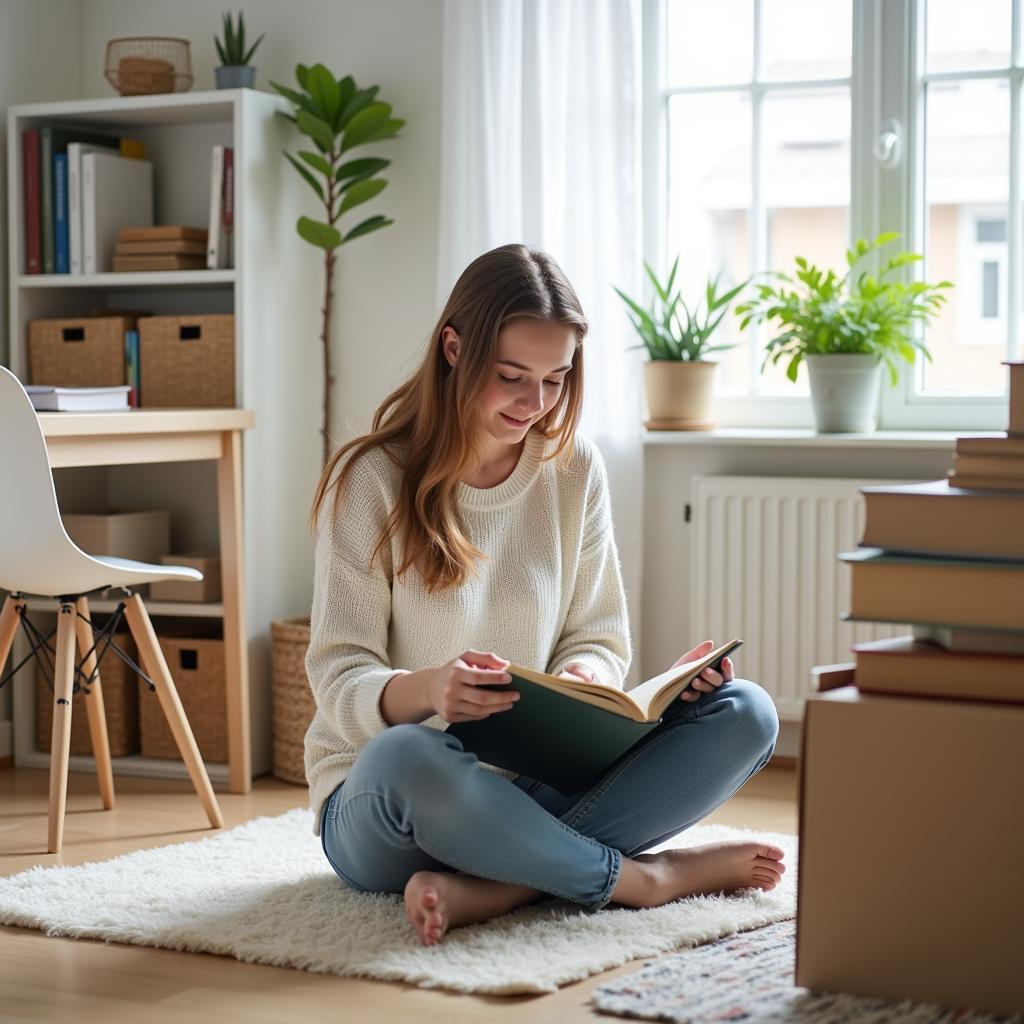A messy room isn’t just about clutter; it can be a visual representation of internal struggles. For many, particularly young women navigating the complexities of life, a “Sad Girl In The Messy Room” becomes a relatable image, reflecting feelings of overwhelm, sadness, and a lack of motivation. This article delves into the psychology behind this phenomenon, exploring the link between mental health and physical space, and offering practical tips for reclaiming both.
The Psychology of Clutter: Why a Messy Room Can Reflect Inner Turmoil
The state of our surroundings often mirrors our internal state. When dealing with difficult emotions like sadness, anxiety, or depression, maintaining a tidy space can feel overwhelming and even impossible. This can lead to a cycle where the mess contributes to feelings of guilt and shame, further exacerbating negative emotions. For the “sad girl in the messy room,” the clutter can become a physical manifestation of her emotional landscape.
Is a Messy Room a Sign of Depression?
While a messy room isn’t a definitive diagnostic criterion for depression, it can be a symptom. The lack of energy and motivation associated with depression can make it difficult to perform everyday tasks, including cleaning and organizing. This can result in a build-up of clutter, contributing to a sense of being trapped and overwhelmed.
 Sad Girl Sitting on the Floor in a Messy Room
Sad Girl Sitting on the Floor in a Messy Room
Reclaiming Your Space, Reclaiming Your Mind: Tips for Tackling the Mess
Transforming a messy room can be a powerful step towards improving mental well-being. It’s not about achieving perfect order, but about creating a space that feels safe, comfortable, and conducive to healing. Start small and focus on achievable goals.
Where to Begin When Your Room Feels Overwhelming
- Start with one area: Choose a small section of your room, like a desk or a corner, and focus on tidying that area first. This can create a sense of accomplishment and motivate you to continue.
- Set a timer: Dedicate just 15-20 minutes each day to tidying. This prevents the task from feeling too daunting and allows you to make gradual progress.
- Break down the task: Instead of thinking about cleaning the entire room, focus on specific actions, like putting away clothes or clearing a surface.
Beyond the Physical: Seeking Support and Self-Care
While tidying your physical space can be beneficial, it’s essential to address the underlying emotional issues contributing to the mess. Seeking support from friends, family, or a mental health professional can provide valuable tools and resources for coping with difficult emotions.
Self-Care Strategies for Emotional Well-being
- Prioritize sleep: Aim for 7-9 hours of quality sleep each night. Sleep is crucial for both physical and mental health.
- Engage in activities you enjoy: Make time for hobbies and activities that bring you joy, even if it’s just for a few minutes each day.
- Practice mindfulness: Engage in activities like meditation or deep breathing to help manage stress and anxiety.
sad girl selfie in messy room often captures a moment of vulnerability. This vulnerability can be a starting point for self-reflection and growth. By understanding the connection between our inner world and our external environment, we can begin to create spaces that support our well-being and empower us to move forward.
what a messy bedroom says about you can provide further insight into the complex relationship between our physical spaces and our mental state.
Conclusion: From Messy Room to Peaceful Sanctuary
A “sad girl in the messy room” isn’t a fixed identity. By taking small steps to reclaim both your physical and emotional space, you can create a more peaceful and supportive environment. Remember, it’s a journey, not a race, and seeking support is a sign of strength, not weakness. Creating a space that reflects your inner peace is a powerful step towards overall well-being.
FAQ
- Is it normal to feel overwhelmed by a messy room? Yes, it’s perfectly normal. A cluttered space can contribute to feelings of stress and anxiety.
- How can I motivate myself to clean when I’m feeling down? Start small, set realistic goals, and focus on the positive impact a clean space can have on your mood.
- What if I can’t seem to keep my room clean? Consider seeking professional help. A therapist can help you identify underlying issues and develop coping strategies.
- Is there a connection between mental health and physical clutter? Yes, research suggests a link between clutter and increased stress levels, difficulty focusing, and feelings of overwhelm.
- What are some simple steps I can take to start decluttering? Begin by choosing one small area to focus on, set a timer for 15-20 minutes, and break down the task into manageable steps.
- How can I maintain a clean room once I’ve tidied it? Develop a regular cleaning routine and try to put things away immediately after using them.
- Where can I find support for my mental health? Reach out to friends, family, or a mental health professional.
 Girl Relaxed in a Clean Room
Girl Relaxed in a Clean Room
When you need support, please contact Phone Number: 0372999996, Email: [email protected] Or visit our address: 236 Cau Giay, Ha Noi. We have a 24/7 customer service team.
Để lại một bình luận